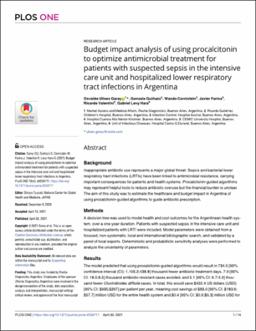| dc.contributor.author | Cornistein, Wanda. | |
| dc.contributor.author | Garay, Osvaldo. | |
| dc.contributor.author | Guiñazú, Gonzalo. | |
| dc.date.accessioned | 2023-05-12T15:32:07Z | |
| dc.date.available | 2023-05-12T15:32:07Z | |
| dc.date.issued | 2021-04 | |
| dc.identifier.citation | PLoS One . 2021 Apr 30;16(4):e0250711. | es |
| dc.identifier.issn | 1932-6203 | |
| dc.identifier.uri | https://riu.austral.edu.ar/handle/123456789/2158 | |
| dc.identifier.uri | https://journals.plos.org/plosone/article?id=10.1371/journal.pone.0250711 | |
| dc.description | Disponible en: https://journals.plos.org/plosone/article?id=10.1371/journal.pone.0250711 | es |
| dc.description.abstract | Abstract
Background: Inappropriate antibiotic use represents a major global threat. Sepsis and bacterial lower respiratory tract infections (LRTIs) have been linked to antimicrobial resistance, carrying important consequences for patients and health systems. Procalcitonin-guided algorithms may represent helpful tools to reduce antibiotic overuse but the financial burden is unclear. The aim of this study was to estimate the healthcare and budget impact in Argentina of using procalcitonin-guided algorithms to guide antibiotic prescription.
Methods: A decision tree was used to model health and cost outcomes for the Argentinean health system, over a one-year duration. Patients with suspected sepsis in the intensive care unit and hospitalized patients with LRTI were included. Model parameters were obtained from a focused, non-systematic, local and international bibliographic search, and validated by a panel of local experts. Deterministic and probabilistic sensitivity analyses were performed to analyze the uncertainty of parameters.
Results: The model predicted that using procalcitonin-guided algorithms would result in 734.5 [95% confidence interval (CI): 1,105.2;438.8] thousand fewer antibiotic treatment days, 7.9 [95% CI: 18.5;8.5] thousand antibiotic-resistant cases avoided, and 5.1 [95% CI: 6.7;4.2] thousand fewer Clostridioides difficile cases. In total, this would save $422.4 US dollars (USD) [95% CI: $935;$267] per patient per year, meaning cost savings of $83.0 [95% CI: $183.6;$57.7] million USD for the entire health system and $0.4 [95% CI: $0.9;$0.3] million USD for a healthcare provider with 1,000 cases per year of sepsis and LRTI patients. The sensitivity analysis showed that the probability of cost-saving for the sepsis patient group was lower than for the LRTI patient group (85% vs. 100%).
Conclusions: Healthcare and financial benefits can be obtained by implementing procalcitonin-guided algorithms in Argentina. Although we found results to be robust on an aggregate level, some caution must be used when focusing only on sepsis patients in the intensive care unit. | es |
| dc.language.iso | en | es |
| dc.publisher | Public Library of Science | es |
| dc.rights | Attribution-NonCommercial-NoDerivatives 4.0 Internacional | * |
| dc.rights.uri | http://creativecommons.org/licenses/by-nc-nd/4.0/ | * |
| dc.subject | Procalcitonin. | es |
| dc.subject | Antimicrobial treatment. | es |
| dc.subject | Sepsis. | es |
| dc.title | Budget impact analysis of using procalcitonin to optimize antimicrobial treatment for patients with suspected sepsis in the intensive care unit and hospitalized lower respiratory tract infections in Argentina | es |
| dc.type | Article | es |


